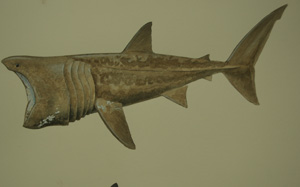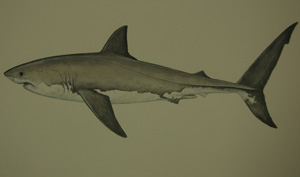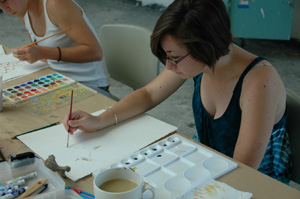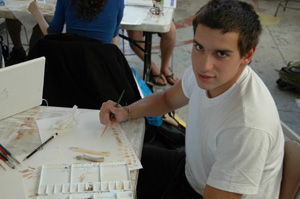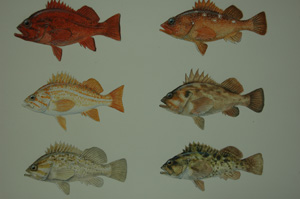Students squinted and leaned close to their ocean artifacts: seal femurs and sand dollars, seaweed twists and dried-out sea stars.
Using graphite pencils and pieces of paper, they tried to make these relics look as realistic as possible, capturing textures, shapes and shadows.
"Typically, people would see this and wouldn't give it a second thought," said UCSC history major Rebecca "Roxy'' Maas, 21, referring to the seaweed loop she was drawing. "They would step right over it.''
But the UCSC Summer Session marine illustration course, taught by professional artist and UCSC graduate Amadeo Bachar, encourages students to notice what they overlooked before.
Starting with bones and shells in pencil, and working their way up to mammals, birds and plants in watercolor, the students will make the Monterey Bay come to life on paper. By the time the class is over, tuna, sea lions and sharks will swim across pieces of paper.
The end result is more than just a pretty picture. Bachar, 35, wants to change the way the class views the world.
"In this class, you learn about diversity,'' said Bachar, a science illustrator whose clients include National Geographic and Scientific American." You learn to connect the pieces of the puzzle.''
When Bachar encourages students to go out into the field with their paints and pencils, he's drawing from a deep pool of knowledge. For one thing, he's a recreational fisherman with an in-depth science background. On top of this, he grew up in Santa Cruz County and knows its seashores well.
"I can point them to great mussel beds near Scott Creek,'' said Bachar, referring to a beach north of Davenport.
Many students, including one who is taking a seven-credit summer-session psychology course, see the class as an escape from stresses. But Bachar does not sugarcoat the fact that painting, and marine illustration in particular, is challenging work.
"The toughest thing is capturing the way light behaves in water,'' Bachar said. "Often, halibut live in brown turbid water where the light is diffuse. But if you're painting blue fin or albacore tuna, the light is completely different. They're out in the pelagic zone 30 to 40 miles from shore where you get clear-blue aquamarine water."
The students are as diverse as the sea life they are painting. Some are studio art and science majors. Others are retirees, and high school students whose parents drive them to class twice a week from as far away as Walnut Creek.
During a recent visit to Bachar's class, the room was quiet, except for the instructor's whispered advice to students, and the sounds of graphite scratching on paper.
Jackson Winn, 20, a UCSC environmental studies and biology major, leaned close to his desk and stared at an elephant seal's baculum, a bone that plays a decisive role in the creature's mating activities. Winn was trying hard to render this object in 3D, capturing its shading, grainy texture and slender profile.
"It's so odd,'' said Winn, an environmental studies major. He found this particular baculum on a scientific trip down to Big Sur. Other students found elephant seal baby skulls and rib bones. "But I am the only one to find a baculum.''
Learning to draw such shapes is a stepping-stone. Winn and others will quickly graduate towards drawing and painting fleshed-out, full-color critters. Then the students start building whole ecosystems on paper.
The end result is a class that will shape the way the students look at ocean life.
"I didn't think it would be that difficult,'' said Sangeeta Nair, 20, an incoming junior at UCSC. She stared hard at the shell she was drawing. "It's the shape,'' she said. "At first I thought it's a simple fan but it's not. There's a little bulge in there that you don't take into account unless you're really looking.''
